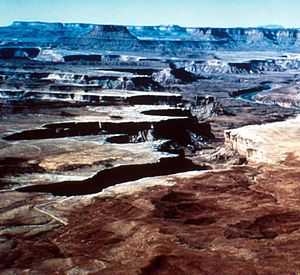Groundwater sapping


Groundwater sapping is the geomorphic process in which groundwater exits a bank or hillslope laterally as seeps and springs and erodes soil from the slope. This often causes the slope to be undermined and undergo mass wasting, hence the word sapping.
This is one of the processes involved in the formation of gullies, such as lavaka. Erosion by sapping tends to produce steep-sided U-shaped valleys of fairly uniform width with box-like, "theater-shaped" headwalls. This contrasts with the more common branching or dendritic pattern of V-shaped valleys produced by overland flows that become wider with distance from their source. Groundwater sapping has been suggested as the cause for erosion of the valley and channel networks on Mars, although studies show that groundwater alone can not excavate and transport the material required to create these canyons.[1]
See also
References
- ↑ Lamb, M. P.; Dietrich, W. E.; Aciego, S. M.; Depaolo, D. J.; Manga, M. (2008). "Formation of Box Canyon, Idaho, by Megaflood: Implications for Seepage Erosion on Earth and Mars". Science 320 (5879): 1067–1070. Bibcode:2008Sci...320.1067L. doi:10.1126/science.1156630. PMID 18497296.
External links
- Simulation of Groundwater Sapping
- Alan D. Howard, "Introduction: Groundwater Sapping on Mars and Earth" in Sapping Features of the Colorado Plateau, edited by A.D. Howard, R. C. Kochel, and H. R. Holt, NASA SP-491, p. 1-5 (1988)
- Julie E. Laity and Michael C. Malin, "Sapping processes and the development of theater-headed valley networks on the Colorado Plateau," Geological Society of America Bulletin: Vol. 96, No. 2 (1985), pp. 203–217 (Abstract).
- T.F. Stepinski and S. Coradetti, "Comparing morphologies of drainage basins on Mars and Earth using integral-geometry and neural maps."